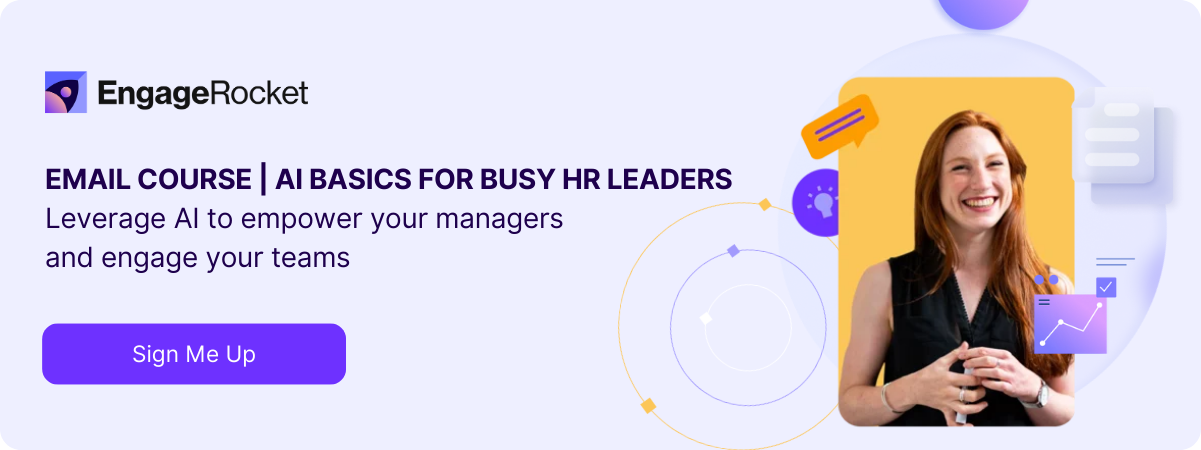In one of our previous content, we discussed at length about using ChatGPT for managers, leaders, and HR. Now, we want to tackle the more practical aspect: how an we go about doing it?
Andreas Welsch, VP at SAP, has pointed out that there are two types of leaders when it comes to implementing AI, those that need to be ambidextrous, and those that are.
As a leader, you can be the champion that elevates productivity through the use of ChatGPT or any new tool by following these steps:
Involve employees early in the process
Organizations often fail to introduce radical changes effectively because they only inform employees about the changes, without engaging them in the process.
To overcome this challenge, it is essential to involve employees in the change process to build ownership and support for the long term.
There are two practical approaches for involving employees in the introduction of ChatGPT tool in the workplace.
1. Engage employees in brainstorming sessions to generate ideas on how the tool can be useful for their work. When employees' ideas are implemented, it enhances their sense of ownership and increases the likelihood of adoption.
2. Consider creating an ambassador program where employees from different parts of the organization are selected based on their interests and contributions. These ambassadors can provide support to other employees and answer their questions related to ChatGPT adoption.
The end goal of involving employees early in the change process is to create a culture of ownership, support, and collaboration.
These are all essential for successful implementation of any new tool or process. This approach increases employee engagement and improves the overall success of the organization's efforts to introduce work changes.
Explore plug and play options for implementing ChatGPT
With the immense popularity of the tool, lots of developments may be popping up in a matter of months or even weeks. Just a few weeks ago, Microsoft already announced that they will be integrating GPT with their Microsoft Teams application to enhance the meeting experience.
Hence, organizations do not need to adopt ChatGPT themselves and instead leverage on existing or new tools that do the implementation leg-work for you, such as EngageRocket's PerformAI.
PerformAI helps managers streamline performance feedback in their teams without leaving their flow of work. It can generate human-like suggestions, share and request for feedback, and track team members’ progress all within Microsoft Teams.
Sell the vision to everyone
Present the reasons why this change would be good for the employees and/or the organization. A compelling vision with solid reasoning will motivate people to adopt the tool and form new habits around it.
More specifically, look into doing the following:
-
Articulate the benefits: This can include improved efficiency, increased productivity, and better decision-making.
-
Demonstrate the value: You should demonstrate the value of ChatGPT by showing how it can be used to solve real-world problems and create new opportunities for the organization.
-
Provide training: This can include online training sessions, workshops, and tutorials. You may also consider engaging an expert who has successfully helped companies adopt new technologies in the past
-
Address concerns: Some employees may raise concerns about privacy and security, as well as concerns about job displacement. It may be beneficial to run a pulse survey to collect feedback about employees' potential concerns in advance
-
Foster a culture of innovation: Leaders should foster a culture of innovation in their organization. This can include encouraging experimentation and risk-taking, and providing resources and support for employees to explore new ideas and technologies.
Develop a concrete change plan
Thoroughly plan the adoption of ChatGPT, including identifying barriers, key performance indicators, project stakeholders and team, and project scope.
Barriers
-
What formal structures make it difficult for employees to adopt ChatGPT?
-
Is there any skills upgrading needed to adopt the tool?
-
Any personnel or information systems that need to be changed to use the tool?
-
Are managers bought in and ready to support the implementation of the new vision?
Key performance indicators
-
What is the current baseline for how things stand?
-
What is considered success in implementing ChatGPT (e.g., increased employee productivity)?
-
How will this success be measured?
-
What is the goal we want to achieve?
Project stakeholders and team
-
Who will oversee the implementation of the new tool?
-
Who will be responsible for implementation?
-
Who needs to be informed of what goes on in this project?
Project scope
-
What are the steps and actions for this implementation project?
-
What falls outside of the project scope?
-
What can be considered as part of future scope?
Show, not just tell
Ensure that managers and leaders use ChatGPT in their flow of work, modeling the behavior they want to see from their employees. Role modeling is crucial for the successful adoption of new tools and behaviors.
When employees see that their leaders are taking real steps in implementing a new tool or technology, they will be more likely to want to adopt these tools themselves. Share some guidance and how-tos that can help to improve productivity and address any barriers that employees may have.
Consider conducting a small-scale pilot project when starting out. This can help to identify potential benefits and challenges, and provide concrete examples of how ChatGPT can be used to improve productivity and efficiency.
About the author

CT Leong is the founder of EngageRocket. Before becoming an entrepreneur, he was a Regional Director of Gallup - one of the world's top HR advisories. He graduated with a degree in Economics at the University of Cambridge, and has an MA in Political Science from Columbia University.

.jpg)


 .
. 